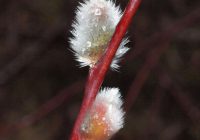Dr Phil Smith’s Wildlife Notes
February 2015
There were only nine “rain-days” in February, the first fortnight being completely dry. Although the regional rainfall for the month was measured at 80% of normal, I suspect that, as usual, the Sefton Coast had far less than that. My perception of a dry winter was confirmed by water-table data for Ainsdale National Nature Reserve provided by Dr Derek Clarke of Southampton University. These show that the mid-winter level was the lowest since 1997/98. This does not augur well for our hard-pressed Natterjack Toads who rely on winter recharge of the water-table to flood their breeding pools.
As usual, February was a quiet month for wildlife sightings but a visit to Mere Sands Wood Nature Reserve was rewarded with close views of four superb Bullfinches on the feeders. At least 16 species of birds and a Brown Rat were taking advantage of the free handouts!
Signs of spring always raise the spirits after a long winter. My first singing Skylark was on 20th, while the following day Common Whitlowgrass was blooming abundantly at Marshside. This tiny white-flowered dune annual is invariably the first to appear. The first Avocets turned up at both Marshside and Martin Mere on 16th, the latter reporting 44 by the end of the month.
Snowdrops are always easy to find in February, almost all being the common Galanthus nivalis. Our best site is at Cabin Hill Wood where it puts on a spectacular show. A small population of the Green Snowdrop (G. woronowii) at Hesketh Road, Marshside, now supports ten large plants with their characteristic broad, bright-green leaves but the single individual of Greater Snowdrop (G. elwesii) that I found a few years ago at Kenilworth Road dunes had no flowers.
Another non-native in flower at this time of year is the Corsican Hellebore; I counted 35 plants at its long-established colony south of Wicks Lake, Formby. Also here is a large population of Primrose, the first flowers of which were just showing, while on the bank above was scatter of Siberian Squill, naturalised here for many years. Several bushes of Siberian Violet-willow were already producing their remarkably furry catkins.
Management activity on our coastline continues apace in winter and I was pleased to see that the National Trust has cleared lots of Gorse on Larkhill Heath, Formby. To tackle the Gorse problem on parts of Freshfield Dune Heath Nature Reserve, the Lancashire Wildlife Trust organised an experimental burn of half a hectare, supervised by a fire crew from Formby Community Fire Station who used it as a training exercise.
Reg Yorke drew my attention to a fascinating 200-year-old account of our area. A voyage around Great Britain by Richard Ayton was published in eight volumes around 1814. Volume 2 (pp. 97-100) finds our hero roughing it on a walk from Liverpool to Southport.: “I now turned from the shore and proceeding for about a mile and a half inland arrived at the village of Formby, sheltered by a few stunted and weather-beaten trees, which, in a neighbourhood generally so bare of wood, were something to boast of. In the morning, I returned to the shore over a waste of sand-hills, on a scale of such grandeur and covering such an extent of ground, that familiarised as I was with sand, the effect was something novel to me. They extended for at least a mile in depth; and were thrown into very striking groups, exactly resembling a range of mountains, with all their ridges, peaks and precipices. Many of them were fully sixty feet in height, rising precipitously on all sides. They were all very thinly sprinkled with the sea-bent, and exhibited a sense of frightful and irredeemable barrenness…. I did at length arrive at some bathing machines….. and paused for a rest at Southport ….. Amidst a waste of sand-hills, there were planted a dozen houses …. The situation is as disagreeable as possible; a windy day smothering you with sand and a calm one suffocating you with heat…. When out of doors, there is no quarter; all is open and exposed, without a tree or a bush to fly to for shade.”
What a difference a couple of centuries make!




